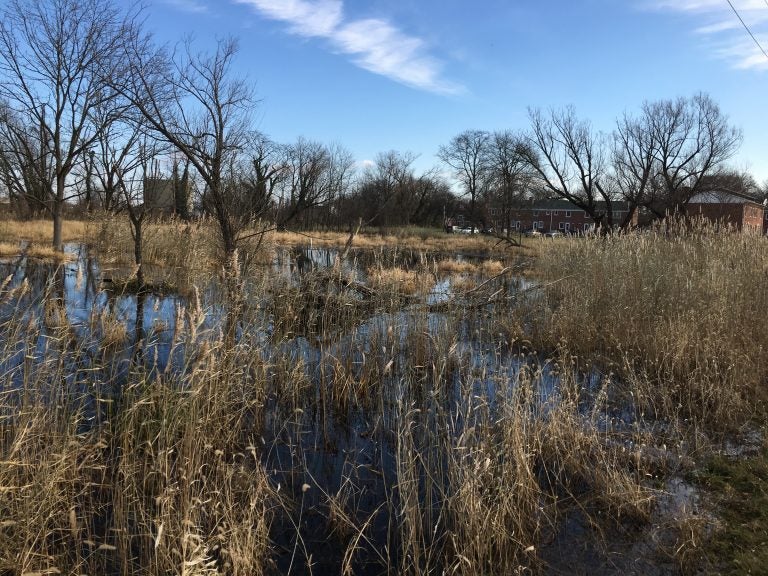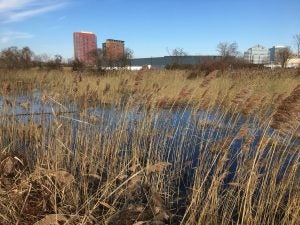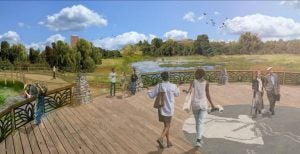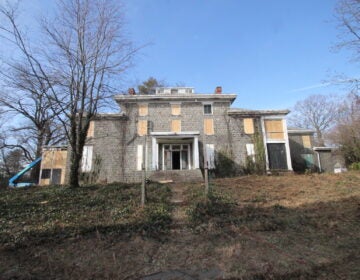Wilmington wetland park project meant to ease flooding gets $3M federal grant
The park will play a key role in reducing the floods that inundate Wilmington's Southbridge section.
Listen 1:19
Standing water sits just behind a row of homes in Wilmington's Southbridge section. The land will soon be turned into a wetland park to prevent flooding. (Mark Eichmann/WHYY)
Plans for a 14-acre wetland park in Wilmington are moving ahead now that the city’s gotten a $3 million federal grant. The park will play a key role in reducing the floods that inundate Wilmington’s Southbridge section.
Right now, this wetland on the south side of Wilmington isn’t functioning properly. It isn’t really functioning at all. A working wetland should retain water during times of high precipitation and then filter that water through the land, supporting lots of native flora and fauna at the same time.
But during a walk through the soggy soil and deep puddles with park project manager Leah Kacanda Thursday morning, evidence of the wetland dysfunction was everywhere.

“This area has been a marsh and a wet wetland area always,” Kacanda said. The tall reeds blowing in the wind are phragmites, an invasive species “It’s a very low-lying flat area that floods frequently, but the flooding is less attached to how much rain we receive and more related to how high the tide is in the Christina [River] when it rains.”
During high tides, water from this area isn’t able to escape back into the Christina; instead, it flows into Southbridge streets and backs up through the sewer system. That’s bad news for Southbridge residents because Wilmington’s combined sewer system mixes that overflowing stormwater with wastewater from nearby homes.
“When household waste gets flushed or you wash your hands, that goes into the same set of pipes that rainfall goes into,” Kacanda said.
The city’s plans to fix the flooding problems in Southbridge include the wetland park as well as separating the storm sewer and wastewater pipes.
“The wetland park is creating a place to put the stormwater,” said Kacanda. “In addition to the park itself — the pretty part we can see in the renderings and we’ll see once construction starts — there will be a project in the neighborhood of Southbridge to separate out the stormwater pipes and the sewer pipes.”
The park itself will feature a mix of wide, crushed-stone paths and boardwalks to allow visitors to experience a natural escape within the city. “When you’re out here, it’s like ‘wow, you’re in the city of Wilmington,’” Kacanda said.

The plan also calls for establishing every wetland plant native to Delaware in the park, including bald cypress trees, which can now only be seen in the very southern part of the state.
“We think it will be a really great place for school groups to come, for bird watchers to come, for people who are avid naturalists, but also for members of the local community, Southbridge, and people who are enjoying the new multi-use trail system. I think it will be a really neat place to come.”
The price tag for the park — including planning, land acquisition, and construction of both the wetland and the sewer separation — is expected be about $26 million. In addition to the $3 million federal grant, the city has also received grant funding from the Nature Conservancy, as well as two low-rate loans from the state Department of Natural Resources and Environmental Control.
The city hopes to start construction in April. The wetland park could open in 2020.
WHYY is your source for fact-based, in-depth journalism and information. As a nonprofit organization, we rely on financial support from readers like you. Please give today.





